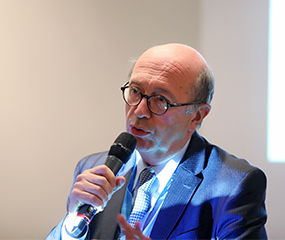 Interview with Pierre Haren
Interview with Pierre Haren
CEO & Co-Founder | Causality Link
Harnessing the potential of artificial intelligence (AI) will require careful collaboration between humans and machines, making the most of their different strengths. In this interview, we talk to Causality Link’s CEO Pierre Haren, who co-founded an AI-powered research platform to extract the knowledge contained within millions of documents and other text-based sources. This provides investors and analysts with a unique perspective on companies, industries and macroeconomics. TSE and Causality Link have been partners for three years, encouraging our researchers in finance and mathematics to share their expert knowledge of causation – not just correlation – and to enrich economic research with the power of predictive analytics.
What led you to the creation of Causality Link?
I had launched ILOG as the second start-up of France’s digital science and technology research institute (INRIA) in 1987, took it public on Nasdaq in 1997, and sold it to IBM in 2008. From this adventure, I learned about the importance of an A-class team, as well as how to work in a private company with research institutes as prestigious as INRIA. I stayed eight years at IBM in different jobs, and finished as vice-president in charge of advanced analytics and Watson (IBM’s question-answering computer system) inside the firm’s 250,000-employee consulting arm (formerly IBM Global Business Services). This was fascinating but I was in too big a company.
So, with a friend and software architect, Eric Jensen, we thought about a different way to use AI than Watson. We created Causality Link in 2016 as a start-up mixing symbolic AI and machine learning to provide a dynamic model of the world by aggregating the knowledge of millions of authors in real-time.
How far along is Causality Link in its development?
We have developed the technical platform, which incorporates 128 million articles in 27 languages, and we buy this content as opposed to scraping the web. We have built solid relationships with our first customers in France, such as the asset manager Amundi and the strategic consulting company Accuracy. And we are actively building partnerships for additional content, or with institutions such as TSE and technology providers, to expand usage of the data we generate.
We are very focused on our current customers’ satisfaction now that we have demonstrated that our process creates valuable insights. And we are preparing to raise Series B funding this year as our space is becoming extremely hot!
How has Causality Link advanced the field of machine learning and its application to complex financial news data?
With large language models and products such as ChatGPT or Bard, machine learning is a very hot topic today. These products take the angle of “statistical AI” where texts are transformed into large vectors of integers and follow a complex machine-learning pipeline to produce a model that can generate other texts from prompts, one most probable word at a time.
We have taken the “symbolic AI” angle, which extracts readable “knowledge blocs” from texts using a large ontology and natural language-processing software, then stores them in a large data lake. Small queries on this data lake can generate “collective insights” in seconds, such as the probability of inflation going up in the future, or time series about the evolution of production for all of the 40,000 companies we track, or alerts when a new potential issue has been detected by a smart author somewhere in the world.
We believe our approach is more appropriate in situations where real-time decisions rely on “explainable AI” rather than powerful black boxes.
What are the main benefits of the partnership for Causality Link?
The partnership offers us different insights on how to derive value from our results. Because we have built something very generic, it is impossible for us to figure out all the ways to use our data, and academics are very good at finding new angles, such as comparing the differential impact of ESG news versus standard financial news on stock prices. Our interactions with TSE and Amundi Research are also pushing us to improve in directions we had not forecasted.
What do you value most about the relationship with TSE researchers?
TSE researchers come from many different backgrounds, offering us a diversity of thinking coupled with extreme competence in their specific domains. We have already tapped our causal graph model to automatically generate Bayesian Belief Networks, but with TSE we believe we will find other fascinating angles to leverage the predictive power of causal links.
What future issues in your sector might be of interest to economists?
I believe that producing large models from millions of texts is the best way to leverage the collective intelligence of researchers and journalists. Because the forces acting on markets and economies are more stable than the everchanging data of the stock market, for example, causality will have a major role to play in the future, especially when we are able to track or even predict regime changes in economies, and mix a continuous understanding of these forces with the potential impact of unforeseeable “black swans”. The guaranteed growing instability of our world will demand good solutions to this problem!
Interview published in TSE Reflect, February 2023
